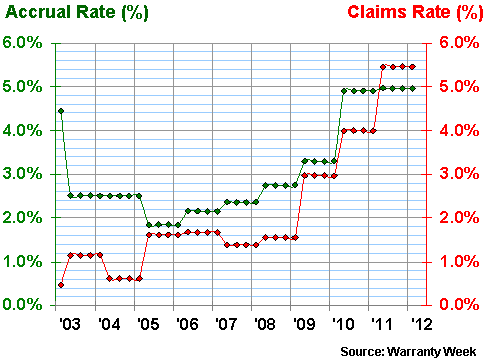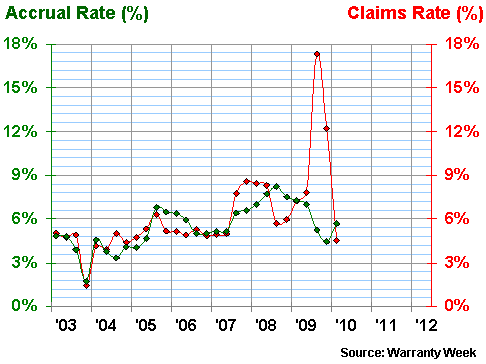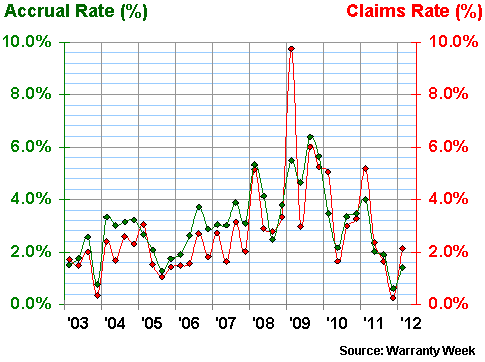Handheld Warranty Costs:
While RIM's costs rise, Apple's costs fall. And while other smartphone makers have reported high warranty costs, Nokia's are only half as high. Is there something about being small and smart that drives up warranty costs?
While handheld mobile computers, phones and electronics in general seem to have higher warranty costs than their tethered cousins, it's not true for every company.
A reader asked why Research In Motion Ltd. seemed to have much higher warranty costs than either Apple Inc. or Nokia Corp. The quick answer is that it's a matter of complexity of design, features, and capabilities, as well as the manufacturer's position, if any, in the extended warranty market.
But of course, there's much more to the story than that.
Wireless Messaging
Research In Motion, or RIM as they're known, sells the BlackBerry line of smartphones through retailers such as Radio Shack, Target and Best Buy, as well as through carriers such as AT&T, Verizon and Sprint. Before the BlackBerry appeared in 1999, RIM sold what were then called wireless email devices or two-way pagers, which used a special data network invented by the Swedish phone manufacturer L.M. Ericsson.
As a Canadian company, RIM is not required to report its warranty costs, as are all American manufacturers. Nevertheless, the company includes warranty expense reports in the footnotes of its annual reports, which we've turned into the chart below.
The company ends its fiscal year in late February or early March. So we've mapped the annual data to cover the second-through-first quarters, with the entire year's claims and accrual rates each spread over four quarters. And what you'll see below are 10 annual measurements of hardware revenue, claims paid and accruals made, stretched over 37 quarters from early 2003 through early 2012.
Figure 1
Research In Motion Ltd.
Warranty Claims & Accrual Rates, 2003-2012
(as a % of product sales)

Notice that while warranty costs seemed to remain within a reasonable range for most of 2003 through 2008, they've been rising steadily ever since. And in fact, RIM's claims rate and accrual rate each hit new highs in the fiscal year ended March 3, 2012.
For the second year in a row, the company set aside about five percent of its hardware revenue as warranty accruals, but its claims rate rose from 4.0% in fiscal 2011 to 5.5% in fiscal 2012. That's on the high side, even for a computer company.
The Cost of Smartness
In general, it's the smartness and/or the mobility that leads to higher warranty costs. A Nokia 1100 mobile phone is roughly the same size as a BlackBerry, but the latter is much "smarter." Laptop computers are about as smart as desktop models, but they're also more mobile. Put a small-and-smart unit into the hands of a not-so-smart customer, and they get broken more often.
We don't have any research to prove that, but if any companies want to spend $50,000 on a bespoke study, we'll create some. Until then, we'll use some close comparables to support our theory and make our point.
Let's start with another company that started out making what were then called personal digital assistants or handheld computers and ended up making what we now call smartphones. Palm Inc. was founded 20 years ago in California, and was then acquired by U.S. Robotics Corp., which was acquired by 3Com Corp. Then in 2000, 3Com spun Palm off into a separate company again, which was acquired two years ago by Hewlett-Packard Co.
For seven of those eleven years, Palm reported its warranty expenses on a quarterly basis. Those reports ceased just before HP acquired the company. And since HP is a huge warranty provider that doesn't break out its expenses by division or by product line, we don't know what those smartphone costs have been like for the past two years.
Rising Costs, Falling Sales
However, one glance at Figure 2 below, and suddenly RIM's recent rise doesn't look so bad. Palm's claims and accrual rates passed 6% for the first time back in 2005, and then passed 7% in 2007. Just before the acquisition, Palm paid out $11.8 million in warranty claims during a quarter with only $68 million in hardware sales, which translates into a whopping 17% claims rate. But that rate spike had more to do with falling sales than with rising warranty costs.
Figure 2
Palm Inc.
Warranty Claims & Accrual Rates, 2003-2010
(as a % of product sales)

Ironically, the moment when Palm's claims rate went through the roof was precisely when the company decided to slash its accrual rate below six percent. That's about as counter-intuitive as it gets. And it kept accruals at that lower level even as the terrible combination of high claims and low sales kept the claims rate high through the end of 2009. But then in its last quarter as an independent company, Palm's claims rate fell below 6% once again, vindicating its accrual rate reduction.
However, even six percent is pretty high. If we assume that five percent is the dividing line between relatively high warranty costs and really unacceptably high warranty costs, then Palm was at or above that danger line long before it ran into sales trouble in 2009. So while that massive 2009 spike can be explained away by a downturn in sales, what about the consistently high rates seen from 2003 to 2008?
The Cost of Basic Mobile Phones
We think Palm's track record demonstrates the inverse relationship between the size of a computer and its warranty cost, as well as the direct relationship between the "smartness" of a mobile phone and its warranty costs. And again, while we can't prove it with research, we can cite comparables.
In Figure 3, we've compiled the annual warranty data reported by Nokia since 2003. The company has manufactured literally billions of "dumb" mobile phones, which nevertheless seem smart enough to know how to survive in the wild without needing much warranty work.
Figure 3
Nokia Corp.
Warranty Claims & Accrual Rates, 2003-2011
(as a % of product sales)

While Palm was paying out 5% of its revenue on a good day to satisfy warranty claims, Nokia paid out half as much on a bad day. Yes, the currencies are different and yes Nokia is orders of magnitude larger than Palm ever was. But the main difference, we think, is in the complexity (and fragility) of the product line. Nokia sells smartphones too. But the bulk of its sales come from what it calls "mass market feature phones."
Compared to GPS Devices
It's not just with smartphones that complexity and mobility come at a price. The same thing seems to happen with handheld GPS navigation devices, as evidenced by the warranty expense reports of Garmin Ltd.
As can be seen in Figure 4 below, the company has paid out as much as 9.7% of its hardware revenue to satisfy warranty claims, though 4% is more of a long-term average. As with the other charts, this one covers the period from early 2003 to early 2012.
Figure 4
Garmin Ltd.
Warranty Claims & Accrual Rates, 2003-2012
(as a % of product sales)

The point is, even if these rates aren't as high as Palm's or RIM's, they're noticeably higher than those that are seen at competing navigation companies such as Trimble Navigation Ltd., Raven Industries Inc., or Xata Corp. One reason is the target market: Garmin is squarely focused on the car-driving consumer while the others are more focused on marine, trucking, farming, and military applications. But the main reason for Garmin's higher rates is the cost of miniaturizing sophisticated features and functions so they can fit into the palm of your hand or onto the dashboard of your car.
iPhone vs. BlackBerry
The reader who prompted this long-winded explanation, however, had a more specific comparison in mind. He wanted to know why RIM's smartphone warranty costs were so much higher than Apple's smartphone warranty costs. He wasn't asking about smart vs. dumb or consumer vs. commercial customers. He was asking about BlackBerry vs. iPhone.
In Figure 5 below, we've detailed Apple's warranty costs over 37 quarters, ending with the first quarter of 2012. And depending upon which data series you look at -- claims or accruals -- you could say that Apple's warranty costs are either drifting down to one percent or slowly rising to 1.5%. Whichever it is, they're a long way from five or six percent.
Figure 5
Apple Inc.
Warranty Claims & Accrual Rates, 2003-2012
(as a % of product sales)

In addition to the usual caveats about no two companies counting warranty precisely the same way, there are probably several other reasons for the difference. First, only 58% of Apple's revenue is iPhone-related, and until a year ago it was under half. So you're also looking at a blend of Macintosh warranty claims as well as iPod and iPad claims.
Second, Apple has been much more successful selling the iPhone directly to its customers, either online or in person at an Apple Store. Therefore, Apple has more opportunities to sell its own brand of extended warranties to its own customers. And given the perceived high value and fragility of an iPhone, these service plans are in high demand.
Extending Technical Support
Another factor helping Apple keep its service contracts in-house is its policy towards technical support. From day 0 to day 90 of ownership, technical support is free under the product warranty. But the service contracts can extend that to two years. But -- and here's the important part -- only Apple's service contracts can extend Apple's technical support.
RIM, on the other hand, is losing out to both the retailers and the carriers, who are eager to push their own plans instead of the manufacturer's. Why is this important? It creates a different urgency for an extended warranty administrator to push claims back onto the product warranty.
When it's a third party plan, the administrator will seek reimbursement from the manufacturer whenever possible. But when it's a manufacturer's own in-house plan, it doesn't matter much whether a claim is processed as an extended warranty or a product warranty cost.
Dell Inc., for instance, used to group them both together. It had separate lines in its financial statements for the extended warranty's deferred revenue and the product warranty's accruals. But there was only one entry for claims paid, whether they were arising from a product warranty or an extended warranty.
It wasn't until the regulators forced the company to account for them separately that Dell began to do so. Yet there are still companies in other industries (such as Cummins Inc. and Deere & Co.) which still don't completely separate their product warranty and extended warranty accounting. But that's a topic for another newsletter.
Apple vs. Apple
To be sure, RIM sells its own brand of BlackBerry Extended Protection Plans. However, the plans are administered by Service Net Warranty, and are underwritten by its parent, Chartis Insurance. So it's not an in-house operation, on the same level as Dell's or Apple's.
The point is, while Radio Shack's or Verizon's administrator might feel compelled to recover whatever costs they can from RIM (or Samsung, or Apple, or any other smartphone maker) if a manufacturer's product warranty overlaps with their extended warranty, Apple doesn't have to recover from Apple. And, we think, one of the factors holding down Apple's product warranty costs is the runaway success of its AppleCare+ service contracts, and the way they can shift costs from one to the other.









